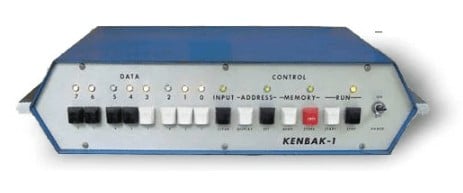5 Facts About Kenbak-1
- The Kenbak-1 computer has a speed of approximately 1Mhz.
- It is famously regarded as the world’s first stored-program PC.
- Only 50 copies of Kenbak-1 were every manufactured.
- The manufacturing company, Kenbak Corporation, was discontinued in 1973.
- Only 40 Kenbak-1 computers were ever sold.
Kenbak-1 History
Kenbak-1 is famously regarded as the first stored-program personal computer created. Created by John V. Blankenbaker in 1971, the Kenbak-1 computers were manufactured by the Kenbak Corporation company and originally sold for $750.

The personal computer was intended to be educational, and the professionals in the field were enthusiastic, but it was a struggle to convince the non-professionals that they could buy a real computer at its selling price. Thus, only some 40 devices were sold, mainly to schools.
Quick Facts
- Created
- 1971
- Creator
- John V. Blankenbaker
- Original Use
- A stored-program computer
- Cost
- $750
The creator of Kenbak-1, John Blankenbaker, had a long experience in computers and their programs. He started the design of a computing device as early as in the winter of 1949 when he was 19 years old and a physics freshman at Oregon State College, inspirited by an article in a magazine. Sometime in the late 1950s, he imagined the existence of simple computers that individuals could afford.
By the spring of 1971, the logic printed circuit board had been built, and the computer was assembled. Designed before microprocessors were available, the logic consisted of small and medium-scale integrated circuits mounted on one printed circuit board. MOS shift registers implemented the serial memory. Switches in the front keyed the input, and lights displayed the output. The memory was two MOS shift registers, each of 1024 bits. The computer was capable of executing several hundred instructions per second.
Despite the brilliance of John’s innovation, only 50 copies of the Kenbak-1 machine were ever manufactured – and as mentioned earlier, only 40 copies were sold. Presently, only 10 Kenbak-1 computers are believed to exist, with different collectors scattered worldwide.
Kenbak-1: How It Worked
The logic board of Kenbak-1 stored programs PC, also called the motherboard contains 132 integrated circuits. The front panel includes the lights and switches connected by wires to the logic board.

The multivibrator generates the machine’s clock of about 1MHz. Several cosmetic and small technical changes were made as the manufacturing company progressed from the prototype unit into the production units. First, they abandoned using a red pushbutton to store data in the memory, replacing it with a toggle switch to lock the memory against changes from the front panel. Also, legends were redesigned and relocated for better visibility; a slot was installed in the front panel for a possible punched card input.
The general format of the instructions was two bytes, where the first byte was the command and the second byte was a constant, a memory address, or a pointer to an address.
The switches and light reflect two numeric representations: the color grouping by four in the switches suggests the hexadecimal number system, while the physical spacing by three suggests the octal number system. Users were encouraged by the coding sheets to write in an assembly language. They had to compile the machine instructions manually, thanks to a high school student who wrote a compiler that ran on a larger computer.
Data, instructions, and addresses were entered by first clearing the Input register with the Clear key and setting the individual bits. The Set Address Key is used to set a memory address to the value in the Input Register. The Store Key stores information in the Input register into the memory at the address previously set up. To read the memory contents, including the A, B, X, and P registers, the address was set, and then the Read Memory key was used. All of these operations were done while the computer was halted.
Kenbak-1: Historical Significance
As mentioned earlier, Kenbak-1 was introduced in 1971 by John Blankenbaker while working in a garage in Los Angeles. Kenbak Corporation, the parent company of the Kenbak-1 computer, stopped producing the machine in 1973, consequently causing CTI Education Products, Inc to take over the production processes. CTI Education Products, Inc rebranded and renamed the Kenbak-1 computer as H5050. Regardless, the computer still found it hard to sell, partially because of the unaffordability of its selling price.
Kenbak-1 computers were created before the first microprocessor; therefore, the machine didn’t include any microprocessor but was based solely on small-scale integration TTL chips plus a memory of 256 bytes.







